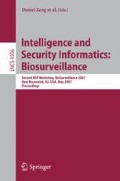Abstract
We have combined two methods to detect anomalies in a time series – in this case in emergency department visit data. The n-gram method applies an existing ICD classifier to a set of emergency department (ED) visits for which both the chief complaint (CC) and ICD code are known. A collection of CC substrings (or n-grams), with associated probabilities, are automatically generated from the training data. This information becomes a CC classifier which is then used to find a classification probability for each patient. The output of this classifier can be used to build volume predictions for a syndromic group or can be combined with a selected threshold to provide syndromic determinations on a per-patient basis. Once the daily volume predictions have been calculated using the n-grams, the HWR anomaly detection algorithm is applied, which alerts both for unusual values and for changes in the overall behavior of the time series in question. The earliest alert was generated by the series of volume predicted by flu n-grams as a proportion of total daily visits.
Access this chapter
Tax calculation will be finalised at checkout
Purchases are for personal use only
Preview
Unable to display preview. Download preview PDF.
References
Burkom, H.S.: Accessible Alerting Algorithms for Biosurveillance. In: 2005 National Syndromic Surveillance Conference (2005)
Chatfield, C., et al.: A new look at models for exponential smoothing. The Statistician, 141-159 (2001)
Halász, S., et al.: The n-Gram CC Classifier: A Novel Method of Automatically Creating CC Classifiers Based on ICD9 Groupings. Advances in Disease Surveillance (2006)
Halász, S., et al.: An Adaptive Anomaly Detection Algorithm. In: ISDS Annual Conference (2006)
Author information
Authors and Affiliations
Editor information
Rights and permissions
Copyright information
© 2007 Springer Berlin Heidelberg
About this paper
Cite this paper
Halász, S., Brown, P., Goodall, C.R., Lent, A., Cochrane, D., Allegra, J.R. (2007). Detecting the Start of the Flu Season. In: Zeng, D., et al. Intelligence and Security Informatics: Biosurveillance. BioSurveillance 2007. Lecture Notes in Computer Science, vol 4506. Springer, Berlin, Heidelberg. https://doi.org/10.1007/978-3-540-72608-1_19
Download citation
DOI: https://doi.org/10.1007/978-3-540-72608-1_19
Publisher Name: Springer, Berlin, Heidelberg
Print ISBN: 978-3-540-72607-4
Online ISBN: 978-3-540-72608-1
eBook Packages: Computer ScienceComputer Science (R0)

